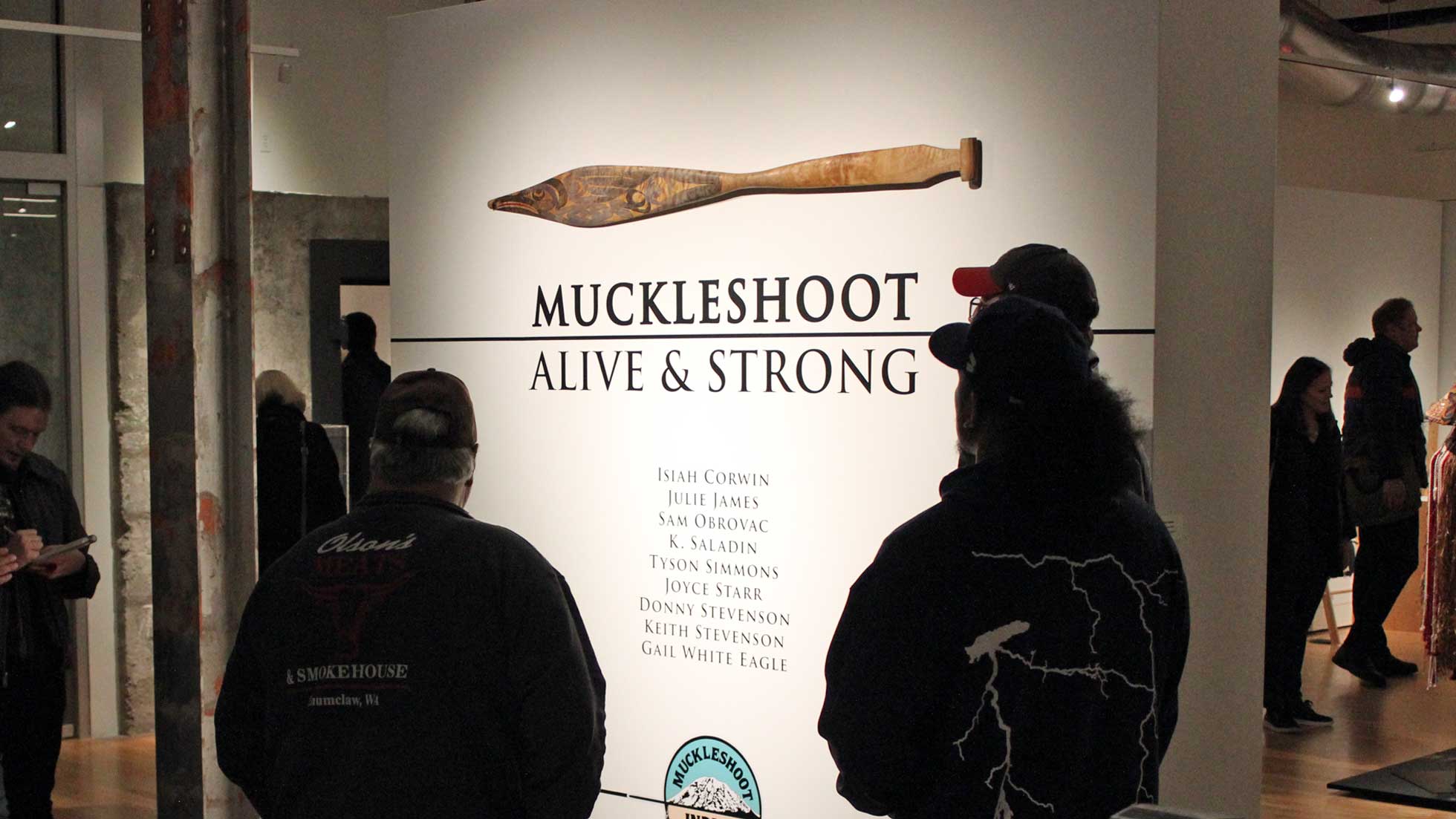From our sister site The Auburn Examiner:
By Raymond Street
On Wednesday evening, Jan. 17, 2024 at the Postmark Center for the Arts in Auburn there was a reception for artists from the Muckleshoot Indian Tribe.
This was my first time visiting the Postmark Center for the Arts. So, while I went to see the art and celebrate, this was also a chance to experience the City of Auburn’s hospitality towards the arts.
For some background, the promotion for the event showed textiles, woodwork, drums, knives, and different styles of paintings. Read more in The Auburn Examiner here.
I arrived a little after 5 p.m., and there were already 60 or so people in the Postmark Center for the Arts. The building used to be a post office, built in 1937 and later renovated to accommodate the arts, including dance, education, cultural programs, music and more. The modern industrial architecture served as a neutral space for the vibrant and living art within.
The main theme of the show, which was first seen upon entry, said “Muckleshoot Alive and Strong” then listed the seven artists beneath. There was the smell of cookies upon entering the building, and to the left, a kitchen that indeed featured fresh baked cookies. People were chatting and laughing, and a docent (helper) welcomed us in. To the right was the Postmark Gift Shop, with prints from previous artists and other swag like stickers, and sports hats designed by Isiah Corwin. His mix of indigenous symbolism and contemporary influences are clear with his clothing brand called Generational Trauma.
The main hall was filled with artwork. In the center was a group of three hand-made outfits. There were handmade rattles, tools from the Muckleshoot Carvers, along with drums and intricately carved weaving instruments.
Within the expanse of the collection, I was drawn to a particular exhibit of art. There was a table set with several wooden rattles with a beautiful abalone inlay. Abalone is a shell from a shoreline creature. Their shells have an iridescent and lustrous shine, like metallic oil. One rattle had a note saying it was okay to gently shake. This offered some participation, a tactile and interactive experience with the artifact.
Behind the table of wooden rattles, there was a wall displaying drums, all crafted and covered in designs from Salish, Pacific Northwest, and contemporary influences. Sometimes they were symmetrical, sometimes featuring a character or creature. Other times they had a mandala appearance with multiple colors and shapes. The mono color designs stood out to me. I saw the style repeated in the artwork displayed in a small alcove called the Vault Gallery.
By 5:30 p.m. there were only over 100 people at the event. Then a city representative used a mic and welcomed everyone. There were thanks given to the artists, a sincere land acknowledgement recognizing the connection and history to the land. They acknowledged Auburn City Councilmembers and Commissioners present in the crowd and their contributions to the arts. Then each artist was given the chance to say a few words and talk about their art.
Gale White Eagle described a connection between her weaving and her ancestors, saying:
“When I am weaving, I am listening to my ancestors.”
This is a common connection described by each artist in their own way. This seemed like a family affair, both living and passed.
The artist Donny Stevenson described his artwork as “good works” and in his native language said how these visual arts and artifacts are methods for the Muckleshoot tribe to connect to their oral tradition and history. The tools were not just on display, but active participants in the process of connecting their ancestors. Donny is the vice chair of the Muckleshoot Tribal Council with over 3,300 members. He described efforts to get artwork and Muckleshoot expression and identity out into the world. He said due to many qualities of the Pacific Northwest, there is a unique and distinct character of this land he loves and is proud of. This is seen in all of their art, clothing, stickers, hair styles, jewelry, music, and all the relationships which come from their creation. Donny also said the Muckleshoot art influence can be seen at Lumen Field at the Muckleshoot Heritage Plaza.
To me, this reception was a celebration of their family, their art, and their role in this world, and their existence. The show will be on exhibit until Mar. 22, 2024.
All the artists, staff and attendees were cheering and clapping for each artist, the energy was high and wholesome. I was also very pleased to see the City of Auburn being hospitable and inclusive of the Muckleshoot Indian Tribe. From outward appearance, they had a professional and thoughtful quality I hope to reflect. Even on the walls immediately outside the building, there was a mural featuring paintbrushes and paints.
I will be following and watching for more art from the Muckleshoot Tribe. Also thank you to all those who were part of the event; all the artists, the site staff, the City of Auburn, The Muckleshoot Tribe, Donney Stevenson, everyone who attended, and all those who came before us.
Photos courtesy Amberraven:







The Postmark Center for the Arts is located at 20 Auburn Ave, Auburn, WA 98002:


